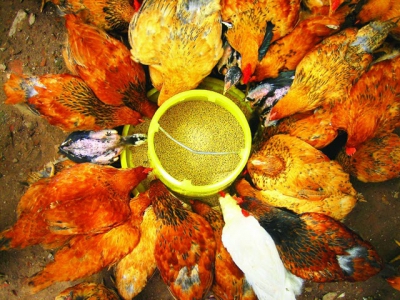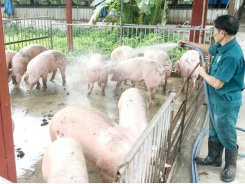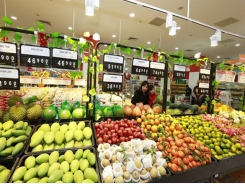Vietnam seeks to industrialize national livestock production

In Vietnam’s agriculture sector, the animal husbandry industry now attracts the largest investment, mostly from the private sector, with plans calling for developing livestock production with competitive advantages in response to domestic and export demand.
Dramatic quantity, quality changes
According to Nguyen Xuan Duong, acting Director General of the Husbandry Department under the Ministry of Agriculture and Rural Development, in the decade since the Prime Minister approved strategies for the development of livestock production until 2020, the Vietnamese husbandry sector has made dramatic changes in both quantity and quality. He spoke at an October 25 event on Strategies of Livestock Development by 2020 and 2030 held by the Ministry of Agriculture and Rural Development.
The husbandry sector has become a major commodity producer with industrial animal breeding farms providing 60 percent of the sector’s output. In the 2008-2018 period, meat production increased by over 1.5 times, eggs by 2.3 times. Animal breeding methods saw a change from households to industrial farms. In 2018, there were only about 2.5 million and 4.5 million households breeding pigs and poultry, respectively, while the number of industrial animal breeding farms had increased to 19,639 units. The husbandry sector has also attracted large investments, especially from the private sector in animal feed production.
The year 2017 marked a historic turning point for the poultry industry, with Vietnam exporting processed chicken to Japan for the first time. Most recently, the Ministry of Agriculture and Rural Development held a ceremony to announce the export of the first batch of Vietnamese milk to China on October 22, marking an important development for Vietnam’s dairy industry.
However, the husbandry sector’s targets and orientation development strategy have not fully appreciated the important role of market factors in the development of the pork segment and land or space for raising cattle. Therefore, the proportion of animal husbandry in agriculture has increased at a low level of about 31.5 to 32 percent, not meeting the 42-percent target.
Industrial farming model
To overcome the shortcomings, Nguyen Xuan Duong said that in the 2020-2030 period, livestock production would be developed by modernizing and industrializing large-scale household farms. The industrial-style animal husbandry will be associated with organic and traditional farming to fully exploit the potential and competitive advantages of each model, and suited to the domestic and export markets.
The husbandry sector will re-organize slaughtering and processing networks to ensure veterinary hygiene, food safety and environmental protection. In the draft strategy of Livestock Development by 2020 and 2030, with a vision until 2040, the animal husbandry industry has set an average growth target of 4 to 5 percent per year from 2020 to 2025, and 3-4 percent in 2026-2030.
Contributing opinions for the draft strategy, Tran Xuan Dong from the Quang Ninh Province’s Sub-Department of Animal Husbandry and Veterinary said Quang Ninh has only some 200 businesses investing in livestock, accounting for over 16 percent of the total animals in the province. It has planned 17 concentrated livestock areas, but it is still unclear how much land each district/commune needs since animal husbandry planning is done later than other sectors, and sometimes not enough land it left for this sector. The local animal husbandry has not fully exploited its strengths and potentials. Every year, the province only meets 60-65 percent of its food demand, with the remaining brought in from Thai Binh and Hai Duong provinces.
Tran Xuan Dong asked authorities to issue a regulation on the amount of land the husbandry sector should be allocated for in agricultural development or else it will be hard to realize the above-mentioned strategy. Hoang Thi To Nga, Deputy Director of Nam Dinh Department of Agriculture and Rural Development said animal husbandry is an economic-technical sector relating to biological and food safety and environmental protection. Therefore, she added, “we need to focus on addressing environmental protection issues”.
Regarding development orientations in the future, Nguyen Ngoc Son from Hanoi’s Sub-Department of Animal Husbandry and Veterinary said the sector needs to focus on certain specific targets like the quality of breeds and products.
According to Deputy Minister of Agriculture and Rural Development Phung Duc Tien, in the period of 2020-2030, animal husbandry needs to be identified as a production and business sector that ensures biological and food safety, environmental protection and humanitarian treatment of animals. It also needs to exploit potentials and advantages aiming at sustainable development, ensuring economic efficiency, basically meeting essential food demand for domestic consumption and exports; and creating jobs for farmers.
The breeding proportion in agricultural production reached only 31.5-32 percent, lower than the target of 42 because the majority of localities focused on planting trees, fruits, vegetables and flowers and had not yet adequately invested in livestock production. In the Central Highlands Mekong River Delta regions, animal breeding accounted for only 15 or 20 percent of agricultural production.
Có thể bạn quan tâm
Phần mềm

Phối trộn thức ăn chăn nuôi

Pha dung dịch thủy canh

Định mức cho tôm ăn

Phối trộn phân bón NPK

Xác định tỷ lệ tôm sống

Chuyển đổi đơn vị phân bón

Xác định công suất sục khí

Chuyển đổi đơn vị tôm

Tính diện tích nhà kính

Tính thể tích ao hồ




 A juicy treat for orange lovers
A juicy treat for orange lovers  Agriculture sector gains trade surplus of $8.8b in…
Agriculture sector gains trade surplus of $8.8b in…